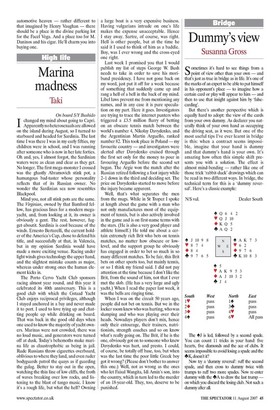The fast Fifties Alan Judd c-isaw Eternity the other night,'
wrote the 17th-century religious poet Henry Vaughan, arrestingly combining the numinous and the mundane. 'I drove a Facel Vega the other day' may not be quite as evocative, but in automotive terms it's not much less likely. Around 3,000 of them were built during the decade 1954-64. They were boulevard supercars, bought by royalty, tycoons, Grand Prix drivers (including Stirling Moss) and glitterati such as Ava Gardner, Ringo Starr and Tony Curtis. It's sometimes wrongly said that Picasso had one; he owned a Mercedes 3005L, but he couldn't drive.
Like much that is memorable in the motor industry, they were the product of one mind: Jean Daninos, an astute French engineer and entrepreneur with a playboy reputation. A former Olympic speed-skater, he was brother of Pierre Daninos, author of the Major Thompson books. In his eighties he maintained two mistresses, both in their forties, and drove a Porsche 911.
Trained by Andre Citroen, he began his industrial career stamping and welding alloys and stainless steel for the aviation industry. Facel (Forges et Ateliers de Construction d'Eure-et-Loir) was his factory at Colombes, the second-largest stamping concern in France, with presses of up to 2,000 tons. It may have been producing 45,000 all-aluminium bodies for Panhard that partly prompted him to indulge his weakness for fast luxury cars by building one himself. But he had also owned six Bentleys, and in 1950 he produced — in agreement with Rolls-Royce — his own version of the Mark VI. Known as the Bentley Cresta, it was as elegant as it is rare (the production run was 17, of which eight are known) and its lines anticipate the Vega. This venture was probably crucial to his decision to build his own car.
Daninos wasn't the first to see the advantage of dropping big American engines — Chrysler V8s up to 6,286cc — into a European chassis wieldy enough to go round corners. But he clothed it in a body that was taut, stylish and capable, filling the gap between the beautiful but ponderous products of Rolls-Royce and the highperformance but erratic and uncomfortable ejaculations of Enzo Ferrari. At once decadent and modernist, it became the world's fastest four-seater coupe. The 355bhp 5.9 litre HK500 of 1958 had a 0-60mph time of 8.5 seconds and a top speed of 140mph, both scarcely credible figures for those days.
The cars were only ever a small part of Daninos's business but they were the part he did himself: 'I was the designer. I was the boss, the general manager, and the styling man. Every car I made at Facel was designed by me. The design, the plaster, the prototypes. It was my business!'
This and much more is to be found in Martin Buckley's new book, Facel Vega: Grand Luxe Sportif Published by the Palawan Press (0207-371 3060, www.palawan.co.uk), this beautifully produced limited edition is sure to be the definitive account. There are 900 cloth-bound copies at £250 each and 100 leather-bound at £750. As with earlier Palawan books on Bristols and the Bentley R-Type Continental, if you own one of the cars you must want the book; and if you can't own one of the cars, the book is the nearest you'll get to it. Wellwritten and engrossing — as much for the personality of Daninos, his dealings and his colourful customers as for the car itself — it is the kind of book you can't just dip into to look up something without reading on, and on.
Simon Draper, owner of Palawan and a discriminating collector, also owns a couple of Facel Vegas. I drove his 1959 Tudor Grey HK500, a manual and one of only 105 righthookers produced. From the front, its lines and stance are slightly reminiscent of an Alvis TD21. But the strikingly curved windscreen, which comes right round to where the quarter-lights would be in the Alvis, soon gives the lie to that. As do the twin exhausts peeping discreetly out from the corners of the rear bumper. The leather seats are wide and comfortable and the stylish dash elegant and simple, with dials in French and English. The dash looks and even feels like wood but it's actually painted metal. The dished wheel is wide and slender and the chrome gearlever is canted appealingly towards the driver.
When you drive it you are immediately back in the 1950s: heavy (but not unmanageable) unassisted steering and clutch, brakes solid rather than sharp and a gearbox that's liquid-smooth provided you get it right (finding third without looking takes practice). The engine is satisfyingly throaty and torquey, the latter making for relaxed motoring. In fact, that's what you do with this car: you motor rather than merely drive. You have to work a bit harder — unlike in a modern car, the steering doesn't take care of itself — which makes you more aware, which in turn makes the experience more interesting. It became very interesting when at 60-65mph in one of the heavier recent downpours one wiper blade flew away.
It's an involving yet surprisingly reassuring drive, a practical daily proposition. The more Mercedes-looking automatic Facel II is said to be even more so, but Simon's was having its engine rebuilt.
Punitive French taxation and government sponsorship of Citroen helped put an end to Daninos's indulgence, but the spirit of exuberance lives on in those who love and treasure such things. Somewhere in the automotive heaven — rather different to that imagined by Henry Vaughan — there should be a place in the divine parking lot for the Facel Vega. And a place too for M. Daninos and his cigar. He'll charm you into buying one.










































 Previous page
Previous page